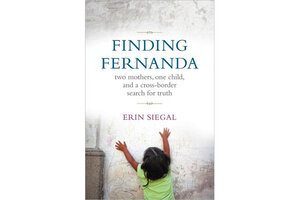Finding Fernanda
Two mothers – one in the US, one in Guatemala – seek the same child in this exposé of the abuses of the international adoption system.

Finding Fernanda
By Erin Siegal
Cathexis Press
300 pp
It’s hard to imagine anyone could dupe a mother into giving up her child for adoption. And it’s tough to relate to a housewife who adopts so many children from abroad that her family swells to nine people. But in Erin Siegal’s debut book, Finding Fernanda, readers have intimate access to two very different women dealing with one overwhelming, complex system.
This well-researched examination of international adoption captures a world of inexplicable actions – some based on religious faith and others purely criminal – through thoughtful detail and an engaging narrative. Siegal began this work as a master’s project for her graduate degree in journalism, working with documents obtained through the Freedom of Information Act, leaked e-mails, and sources in the US and Guatemalan governments. “Finding Fernanda” – released just in time for National Adoption Month and which Siegal has published at her own expense – reads like a mystery novel, but the facts it reveals are hauntingly true.
In 2006, Mildred Alvarado was a struggling single mother living outside Guatemala City, one of the poorest and most dangerous cities in the Western Hemisphere. Betsy Emanuel was a devout Christian living in rural Tennessee with a house full of kids between the ages of 1 and 19 years old, a loving husband, and a pony in the backyard. Siegal frames her investigation into Guatemalan adoption around the palpable love both Alvarado and Emanuel have for their children and their faith in God. Despite their myriad differences, Alvarado and Emanuel share an ability to see the very best in people: a characteristic that made them vulnerable to deceit – but eventually also served to bring them together in search of a young child they both claimed as their own.
Alvarado was raising three children and expecting her fourth when an acquaintance put her in touch with a couple who offered to take her and her children in for the remaining months of her pregnancy, a generous proposal that seemed too good to be true. “Lately, in an attempt to cling to the remains of her tattered pride, she’d taken to praying every night.... Maybe this was God’s doing, she thought, bewildered,” Siegal writes of Alvarado.
Alvarado accepted the invitation, and after a series of criminal events disguised as kindness, discovered that her two youngest children had been taken from her and were being falsely advertised as available for adoption in the United States.
Siegal weaves the history of Guatemala and international adoption into her narrative, explaining how a system as seemingly altruistic as adoption could tumble into such criminality and corruption. US families began adopting from Guatemala in the 1980s, at the height of a violent civil war that left many children orphaned. Adoption proved a great source of revenue for the economically deflated country and – unfortunately – Guatemalan children became commodities.
Unscrupulous locals worked as baby-finders in Guatemala, conning mothers like Alvarado and even cutting infants from pregnant bellies. Corruption in government institutions and among professionals – including lawyers, judges, doctors, police, and child-care professionals – led to extraordinary compliance with unlawful adoptions. Siegal portrays the shocking lack of regulation and oversight between US and Guatemalan officials, as children were in effect stolen from loving families and falsely offered up for adoption around the world.
In the fall of 2006, Emanuel, the Tennessee mother, was slated to adopt Alvarado’s daughter Fernanda. This was Emanuel’s fifth international adoption, but her first from Guatemala. She was told by the US adoption agency Celebrate Children International that the child’s family was too poor to care for her, a sad story that seemed rampant in developing countries. But, a year and a half later Emanuel stumbled upon a shocking reality: A Guatemalan newspaper article described Alvarado’s desperate search to find her abducted daughter, Fernanda. Emanuel instantly called the newspaper’s offices in Guatemala, setting in motion a series of incredible events.
Guatemala suspended all new cases of international adoption in 2008, but “[b]etween 2008 and 2010, CICIG [a United Nations commission investigating impunity in Guatemala] found that just 10 percent of all children who left Guatemala in adoption were legal orphans,” Siegal writes.
Siegal does a fantastic job of breaking down a complicated story, and gives voice to the distinct players involved in Guatemalan children being adopted by US families. “Finding Fernanda” is a gripping read that offers glimpses of hope in what was an otherwise heartbreaking system.
Whitney Eulich is a Monitor correspondent.
